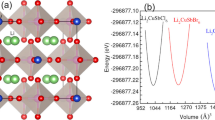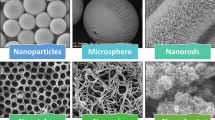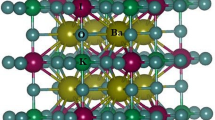Abstract
Adsorbing halogen and alkali metals atoms modify the optical and electrical characteristics of WSe2 monolayer (2D). The electrical and optical characteristics of the Wse2 monolayer, alkali and halogen atoms adsorbed WSe2 structures are investigated through density functional theory (DFT) simulations. The pristine WSe2 monolayer has insignificant absorption in the infrared and most parts of the visible region, and substantial absorption in the ultraviolet (UV) region (λ < 410 nm) as well as in a small section of the visible spectrum. The absorption coefficient of alkali–halogen adsorbed structures of WSe2 seems to expand with wavelength, and absorption peaks move toward the higher energy region of the optical spectrum, resulting in redshift effect. Significant absorption is observed in the entire visible spectrum (~ 410 to 780 nm) for both alkali and halogen adsorbed WSe2 nanostructures. The chlorine, bromine, and iodine adsorbed WSe2 structure shows larger absorption in the entire visible region among all other adsorbed structures. Presence of absorption peaks in the visible range of wavelengths rather than in the UV region, is beneficial for optoelectronic applications such as LEDs, CRTs, solar cells, and sensors. Trends in computed dielectric constant and refractive index values are also found to be compatible with trends in absorption coefficient values.





Similar content being viewed by others
Data availability
All data generated and analyzed during this study are included in this published article in the form of plots and its supplementary information files. The raw/detailed datasets generated during the current study are available from the corresponding author on request.
References
A.H.C. Neto, F. Guinea, N.M.R. Peres, K.S. Novoselov, A.K. Geim, The electronic properties of graphene. Rev. Mod. Phys. 81(1), 109–162 (2009)
J.A. Wilson, A.D. Yoffe, Transition metal dichalcogenides: discussion and interpretation of observed optical, electrical and structural properties. Adv. Phys. 18, 193–335 (1969)
W. Choi, N. Choudhary, G.H. Han, J. Park, D. Akinwande, Y.H. Lee, Recent development of two-dimensional transition metal dichalcogenides and their applications. Mater. Today 20(3), 116–130 (2017)
L. Gan, Q. Zhang, Y. Zhao, Y. Cheng, U. Schwingenschlogl, Order-disorder phase transitions in the two-dimensional semiconducting transition metal dichalcogenide alloys Mo1_xWxX2 (X = S, Se, and Te). Sci. Rep. 4, 6691 (2014)
T. Taylor, Abundance of chemical elements in the continental crust: a new table. Geochim. Cosmochim. Acta 28, 1273–1285 (1964). https://doi.org/10.1016/0016-7037(64)90129-2
Q.H. Wang, K. Kalantar-Zadeh, A. Kis, J.N. Coleman, M.S. Strano, Electronics and optoelectronics of two-dimensional transition metal dichalcogenides. Nat. Nanotechnol. 7(11), 699–712 (2012)
F. Zhang, W. Li, Y. Ma, Y. Tang, X. Dai, Tuning the Schottky contacts at the graphene/WS2 interface by electric field. RSC Adv. 7, 29350–29356 (2017)
N.R. Pradhan et al., Metal to insulator quantum-phase transition in few-layered ReS2. Nano Lett. 15(12), 8377–8384 (2015)
B. Liu, M. Cai, Y. Zhao, L. Wu, L. Wang, First-principles investigation of the Schottky contact for the two- dimensional WSe2 and graphene heterostructure. RSC Adv. 6, 60271–60276 (2016)
A. Efiekhari, Tungsten dichalcogenides (WS2, WSe2, and WTe2): material chemistry and applications. J. Mater. Chem. A 5(35), 18299–18325 (2017)
H. Yuan, M.S. Bahramy, K. Morimoto, S. Wu, K. Nomura, B. Yang, H. Shimotani, R. Suzuki, M. Toh, C. Kloc, X. Xu, R. Arita, N. Nagaosa, Y. Iwasa, Zeeman-type spin splitting controlled by an electric field. Nat. Phys. 9, 563–569 (2013). https://doi.org/10.1038/nphys2691
D. Xiao, G. Liu, W. Feng, X. Xu, W. Yao, Coupled spin and valley physics in monolayers of and other group-VI dichalcogenides. Phys. Rev. Lett. 108, 196802 (2012). https://doi.org/10.1103/PhysRevLett.108.196802
J. Gobrecht, H. Gerischer, H. Tributsch, Electrochemical solar cell based on the d-band semiconductor tungsten-diselenide. Ber. Bunsenges. Phys. Chem. 82(12), 1331–1335 (1978). https://doi.org/10.1002/bbpc.19780821212
F. Xia, H. Wang, Di. Xiao, M. Dubey, A. Ramasubramaniam, Two-dimensional material nanophotonics. Nat. Photon. 8(12), 899–907 (2014). https://doi.org/10.1038/nphoton.2014.271
X. Zhang, X.-F. Qiao, W. Shi, J.-B. Wu, D.-S. Jiang, P.-H. Tan, Phonon and Raman scattering of two-dimensional transition metal dichalcogenides from monolayer, multilayer to bulk material. Chem. Soc. Rev. 44(9), 2757–2785 (2015). https://doi.org/10.1039/C4CS00282B
B. Yu, B. Zheng, X. Wang, F. Qi, J. He, W. Zhang, Y. Chen, Enhanced photocatalytic properties of graphene modifed few-layered WSe2 nanosheets. Appl. Surf. Sci. 400, 420–425 (2017). https://doi.org/10.1016/j.apsusc.2016.12.015
J.R. McKone, R.A. Potash, F.J. DiSalvo, H.D. Abruna, Unassisted HI photoelectrolysis using N-WSe2 solar absorbers. Phys. Chem. Chem. Phys. 17, 13984–13991 (2015). https://doi.org/10.1039/c5cp01192b
Z. Zheng, T. Zhang, J. Yao, Y. Zhang, J. Xu, G. Yang, Flexible, transparent and ultra-broadband photodetector based on large-area WSe2 film for wearable devices. Nanotechnology 27, 225501 (2016). https://doi.org/10.1088/0957-4484/27/22/225501
S. Jo, D. Kang, J. Shim, J. Jeon, M.H. Jeon, G. Yoo, J. Kim, J. Lee, G.Y. Yeom, S. Lee, H. Yu, C. Choi, J. Park, A high-performance WSe2/h-BN photodetector using a triphenylphosphine (PPh3)-based N-doping technique. Adv. Mater. 28, 4824–4831 (2016). https://doi.org/10.1002/adma.201600032
L. Ye, P. Wang, W. Luo, F. Gong, L. Liao, T. Liu, L. Tong, J. Zang, J. Xu, W. Hu, Highly polarization sensitive infrared photodetector based on black phosphorus-on-WSe2 photogate vertical heterostructure. Nano Energy 37, 53–60 (2017). https://doi.org/10.1016/j.nanoen.2017.05.004
T. Roy, M. Tosun, M. Hettick, G.H. Ahn, C. Hu, A. Javey, 2D–2D tunneling field-effect transistors using WSe2/SnSe2 heterostructures. Appl. Phys. Lett. 108, 083111 (2016). https://doi.org/10.1063/1.4942647
J. Xu, J. Shim, J. Park, S. Lee, MXene electrode for the integration of WSe2 and MoS2 field effect transistors. Adv. Funct. Mater. 26, 5328–5334 (2016). https://doi.org/10.1002/adfm.201600771
W. Kang, I. Cho, J. Roh, C. Lee, J. Lee, High-gain complementary metal-oxide-semiconductor inverter based on multi-layer WSe2 field effect transistors without doping. Semicond. Sci. Technol. 31, 105001 (2016). https://doi.org/10.1088/0268-1242/31/10/105001
S.J. Hong, M. Park, H. Kang, M. Lee, D.H. Jeong, Y.W. Park, Fabrication and independent control of patterned polymer gate for a few-layer WSe2 field-effect transistor. AIP Adv. 6, 085320 (2016). https://doi.org/10.1063/1.4961990
J. Park, I. Cho, W. Kang, B. Park, J. Lee, Elimination of the gate and drain bias stresses in I–V characteristics of WSe2 FETs by using dual channel pulse measurement. Appl. Phys. Lett. 109, 053503 (2016). https://doi.org/10.1063/1.4960459
B. Liu, Y. Ma, A. Zhang, L. Chen, A.N. Abbas, Y. Liu, C. Shen, H. Wan, C. Zhou, High-performance WSe2 field-effect transistors via controlled formation of in-plane heterojunctions. ACS Nano 10, 5153–5160 (2016). https://doi.org/10.1021/acsnano.6b00527
H.C.P. Movva, A. Rai, S. Kang, K. Kim, B. Fallahazad, T. Taniguchi, K. Watanabe, E. Tutuc, S.K. Banerjee, High-mobility holes in dual-gated WSe2 field-effect transistors. ACS Nano 9, 10402–10410 (2015). https://doi.org/10.1021/acsnano.5b04611
L. Qiao, C.Q. Qu, H.Z. Zhang, S.S. Yu, X.Y. Hu, X.M. Zhang, W.T. Zheng, Effects of alkali metal adsorption on the structural and field emission properties of grapheme. Diam. Relat. Mater. 19(11), 1377–1381 (2010)
Y. Ding, Y. Wang, Structural, electronic, and magnetic properties of adatom adsorptions on black and blue phosphorene: a first-principles study. J. Phys. Chem. C119(19), 10610–10622 (2015)
V.V. Kulish, O.I. Malyi, C. Persson, P. Wu, Adsorption of metal adatoms on single-layer phosphorene. Phys. Chem. Chem. Phys. 17(2), 992–1000 (2015)
R. Kochar, S. Choudhary, WSe2/phosphorene heterostructure for optical absorption in visible region. IEEE J. Quantum Electron. 54(4), 1–6 (2018)
C. Tan, Q. Yang, R. Meng, Q. Liang, J. Jiang, X. Sun, H. Ye, An AlAs/germanene heterostructure with tunable electronic and optical properties via external electric field and strain. J. Mater. Chem. C 4(35), 8171–8178 (2016)
J. Jiang, Q. Liang, R. Meng, Q. Yang, C. Tan, X. Sun, X. Chen, Exploration of new ferromagnetic, semiconducting and biocompatible Nb3X8 (X = Cl, Br or I) monolayers with considerable visible and infrared light absorption. Nanoscale 9(9), 2992–3001 (2017)
T. Zhenwei, X. Yu, X. Fei, J. Liu, Y. Zhao, H. Wu, G. Yang, S. Yang, L. Yang, Synthesis and optical properties of halogen-doped ZnO phosphor. Mater. Lett. 62, 3018–3020 (2008)
W.C. Simpson, J.A. Yarmoff, Fundamental studies of halogen reactions with III–V semiconductor surfaces. Annu. Rev. Phys. Chem. 47(1), 527–554 (1996)
B.N. Dev, K.C. Mishra, W.M. Gibson, T.P. Das, First-principles investigation of location and electronic structure of adsorbed halogen atoms on semiconductor surfaces. Phys. Rev. B 29(2), 1101–1104 (1984)
R.G. Jones, Halogen adsorption on solid surfaces. Prog. Surf. Sci. 27(1–2), 25–160 (1988)
M. Tyagi, S. Choudhary, Tuning the electronic and optical properties of the monolayer by adsorbing halogen and alkali metals. IET Opotelectron. 15, 1–11 (2021)
P. Tyagi, S. Choudhary, Tuning the electronic and optical properties of molybdenite (WSe2) by adsorption of alkali metals and halogens. Opt. Mater. 118, 111248 (2021)
J.P. Perdew, K. Burke, M. Ernzerhof, Generalized gradient approximation made simple. Phys. Rev. Lett. 77, 3865–3868 (1996)
G. Kresse, J. Furthmuller, Efficient iterative schemes forab initio total-energy calculations using a plane-wave basis set. Phys. Rev. B 54, 11169 (1996)
H.J. Monkhorst, J.D. Pack, Special points forbrillouin-zone integrations. Phys. Rev. B 13, 5188 (1976)
P. BlahaTran, Accurate band gaps of semiconductors and insulators with a semilocal exchange-correlation potential. Phys. Rev. Lett. 102, 226401 (2009)
R.I. Eglitis, Ab initio hybrid DFT calculations of BaTiO3, PbTiO3, SrZrO3 and PbZrO3 (111) surfaces. Appl. Surf. Sci. 358, 556–562 (2015)
W.A. Harrison, Solid State Theory (McGraw-Hill, New York, 1970)
G.R. Berdiyorov, Optical properties of functionalized Ti3C2T2 (T = F, O, OH) MXene: first-principles calculations. AIP 6(5), 055105 (2016)
R.M. Martin, Electronic Structure: Basic Theory and Practical Methods (Cambridge University Press, New York, 2004)
D.J. Griffiths, Introduction to Electrodynamics, 3rd edn. (Prentice Hall, Hoboken, 1999)
W. Schutte, J. De Boer, F. Jellinek, J. Solid State Chem. 70, 207 (1987)
D. Muoi, N.N. Hieu, H.T. Phung, H.V. Phuc, B. Amin, B.D. Hoi, P.T.T. Le, Electronic properties of WS2 and WSe2 monolayers with biaxial strain: a first-principles study. Chem. Phys. (2018). https://doi.org/10.1016/j.chemphys.2018.12.004
R. Fletcher, Practical Methods of Optimization, 2nd edn. (Wiley, New York, 1987)
P. D’Amico, A. Calzolari, A. Ruini, A. Catellani, New energy with ZnS: novel applications for a standard transparent compound. Sci. Rep. (2017). https://doi.org/10.1038/s41598-017-17156-w
Funding
The authors declare that no funds, grants, or other support were received during the preparation of this manuscript.
Author information
Authors and Affiliations
Contributions
MT was involved in formal analysis, writing original draft, developed the theoretical formalism and performed the analytic calculations and the numerical simulations. SC was involved in supervision. Both authors discussed the results and commented on the manuscript and contributed to the final version of the manuscript.
Corresponding author
Ethics declarations
Conflict of interest
The authors have no relevant financial or non-financial interests to disclose.
Additional information
Publisher's Note
Springer Nature remains neutral with regard to jurisdictional claims in published maps and institutional affiliations.
Rights and permissions
Springer Nature or its licensor holds exclusive rights to this article under a publishing agreement with the author(s) or other rightsholder(s); author self-archiving of the accepted manuscript version of this article is solely governed by the terms of such publishing agreement and applicable law.
About this article
Cite this article
Tyagi, M., Choudhary, S. Changes in electronic and optical characteristics of halogen–alkali adsorbed WSe2 monolayer. J Mater Sci: Mater Electron 33, 21022–21033 (2022). https://doi.org/10.1007/s10854-022-08907-1
Received:
Accepted:
Published:
Issue Date:
DOI: https://doi.org/10.1007/s10854-022-08907-1




